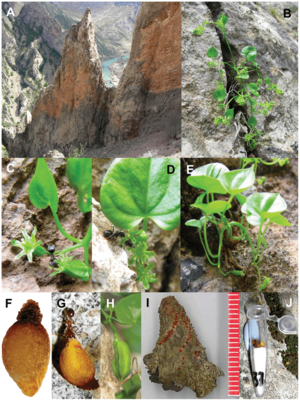Dioscorea chouardii facts for kids
Quick facts for kids Dioscorea chouardii |
|
|---|---|
 |
|
| Scientific classification | |
| Genus: |
Dioscorea
|
| Species: |
chouardii
|
| Synonyms | |
|
Borderea chouardii (Gaussen) Gaussen & Heslot |
|
Dioscorea chouardii (also known as Borderea chouardii) is a special plant that grows from a tuber (a thick underground stem). It belongs to the plant family called Dioscoreaceae, which includes yams. This plant is endemic, meaning it is found naturally in only one specific place in the world. That place is a single cliff in the Pyrenees mountains, located in Aragon, Spain.
Contents
Discovering Dioscorea chouardii
This unique plant was first found in the 1950s. It was growing in tiny cracks in a limestone cliff in the Pyrenees Mountains, in northeastern Spain. Because the cracks were so hard to reach, it was tough to count how many plants there were.
At first, people thought there were only about 300 to 500 plants. But later, with the help of scaffolding (a temporary structure for workers) and tools like binoculars and telescopes, scientists could get a much better look. They were then able to count around 9,000 individual plants!
How Dioscorea chouardii Grows
Dioscorea chouardii is related to the yam, which is a vegetable we eat. This plant grows from a tuber that stays hidden deep inside the rock cracks. Every year, a new shoot (a stem with leaves) grows out from the tuber. In the autumn, this shoot dies away.
When the shoot dies, it leaves a small scar on the tuber. Scientists can count these scars to guess how old the plant is. Some of the oldest plants are thought to be up to 300 years old! This makes them some of the "slowest growing plants in the world."
The plant makes new plants using seeds. Tiny ants help with pollination, which means they carry pollen from one flower to another. After the flower is pollinated, its stem bends down. This helps bury the seedhead into the crack in the rock. When the seedhead dries, the seeds are released. Ants then pick up these seeds and carry them to new places, helping the plant spread.
A Plant from the Past
Most plants in the Dioscorea family grow in warm, tropical places. But Dioscorea chouardii lives in the cooler Pyrenees. This makes it a "relict species." This means it's a leftover from a much warmer time in Earth's history, like the Eocene epoch, millions of years ago.
Dioscorea chouardii looks very similar to another relict plant called D. pyrenaica. D. pyrenaica is found in more places across the Pyrenees. D. chouardii prefers to grow in vertical cracks on shaded, north-facing limestone cliffs, usually between 730 and 850 meters (about 2,400 to 2,800 feet) high. D. pyrenaica, on the other hand, grows on rocky slopes at over 1,800 meters (about 5,900 feet). Scientists have done special tests that show these two plants are indeed separate species, even though they look alike.
Protecting Dioscorea chouardii
Because Dioscorea chouardii is so rare and special, it is protected. In 1992, it was named a 'priority species' by the European Community. This means that areas where it grows can be made into Special Areas of Conservation.
Today, in the European Union, there are seven special areas called Natura 2000 sites set up to protect this plant. The EU has also officially said that this plant is 'critically endangered'. Even though its home is very small, the number of these plants seems to be stable. Scientists don't think climate change will harm it too much.
See also
 In Spanish: Dioscorea chouardii para niños
In Spanish: Dioscorea chouardii para niños

